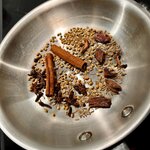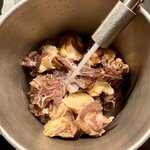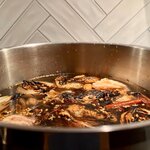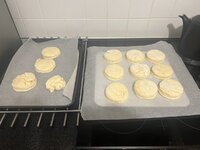Might as well re-post my Instant Pot Red Beans and Rice recipe:
New Orleans Style Red Beans and Rice
original recipe by J. Kenji Lopez-Alt, adapted for Instant Pot
- 1 pound dry Central American (small) Red Beans, picked over
- kosher salt
- 1 tbsp vegetable oil, bacon fat, or lard
- 1 pound cooked andouille or other smoked sausage, cut into ½ inch thick rounds
- 1 large onion, finely chopped
- 1 green bell pepper, stemmed, seeded and finely chopped
- 4 ribs celery, finely chopped
- 4 medium cloves of garlic, minced
- ½ tsp to 1 tbsp ground cayenne (exercise good judgment)
- 1 tsp ground sage
- freshly ground black pepper
- 1 smoked ham hock (optional, see note)
- 4 sprigs fresh thyme
- 3 bay leaves
- hot sauce (Crystal is traditional)
- cider vinegar (see note)
note: pickled pork is traditional, but can be hard to find. If you've got access to it, use in place of the smoked ham hock and cider vinegar.
Set Instant Pot to saute on high heat and add oil/fat. Add sausage and saute until lightly browned, 3-5 minutes. Add onion, bell pepper, and celery. Season with salt, then cook, stirring frequently, until the vegetables have softened and are just beginning to brown around the edges, about 8 minutes.
Add garlic and cook, stirring, until fragrant, about 45 seconds. Add cayenne pepper, sage, and 10-12 generous grinds of black pepper. Cook, stirring, until fragrant, about 30 seconds. Add beans, enough water to cover by about an inch (6-8 cups), ham hock (if using), thyme, and bay leaves.
Seal with lid, making sure the release valve is closed, and cook on high pressure for 70 minutes. When cook time is complete, press ‘cancel’ to end the keep-warm mode, and let sit for 15 to 20 minutes to depressurize.
Open lid and use tongs to fish out ham hock, bay leaves, and thyme stems, mash beans lightly with a wooden spoon or potato masher, if desired, and simmer on Sauté setting, stirring occasionally, until it reaches your desired texture. Season to taste with hot sauce, cider vinegar (a few teaspoons to start) and salt and pepper.
Serve over steamed rice.





